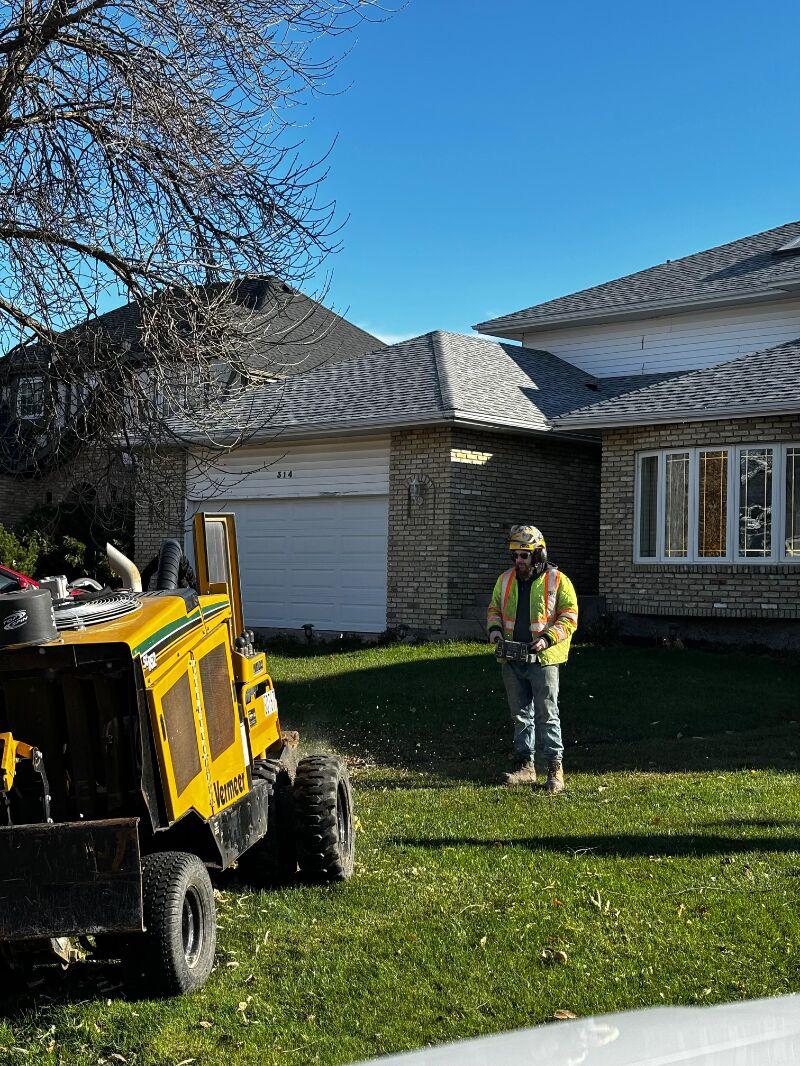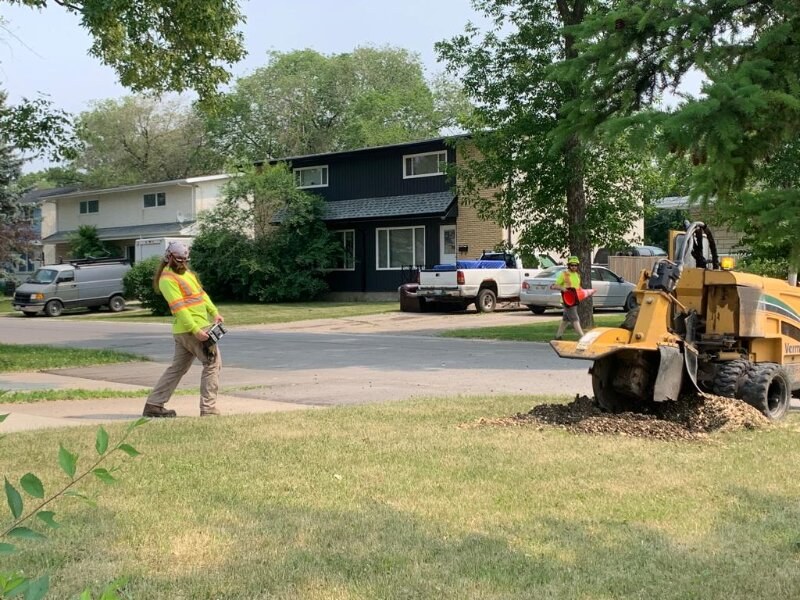When is Stump Grinding the Best Choice for Your Property?
Reading time: 8 minutesOnce you have a tree cut down, you’re left to deal with the stump. Contrary to popular belief, you can’t just let the stump break down naturally over time. This process is very slow and invites unwanted pests, mold, and fungi.
How you get rid of the stump matters; not every removal process is good for the environment. One of the more eco-friendly stump removal methods is grinding.
Here’s what you should know about stump grinding and when it’s the best choice for removing a tree stump on your property.

What Is Stump Grinding?
Stump grinding is the process of crushing and pulverizing the top of a tree stump with a powerful machine specially designed for this purpose. The machine looks like a riding lawnmower with a circular saw attached to the bottom.
This blade rotates and chews up the dense wood and cuts it up into small pieces that can be used for mulch or compost. The grinder removes the stump just below the surface, leaving the root system intact but allowing you to level the ground and grow grass over the top as if there were never a stump at all. It’s strong enough to make quick work of the base of the tree and can even handle a few rocks along the way.
Most of the time, a stump can be ground out in about two hours. Very large tree stumps may take four to six hours, depending on the size and age of the tree and its location. Hickory, mahogany, and oak trees take the longest to grind since their wood is exceptionally hard and difficult to cut into small pieces.
How Deep Does a Stump Grinder Go?
A stump grinder typically goes down to about 15 to 20 centimetres for most jobs, but some equipment can go much deeper if needed to break down tough wood or large stumps with extensive root systems.
Advantages of Grinding Over Removal
There are many advantages of stump grinding over removing the stump, like:
It Removes Unsightly Tree Stumps
Cutting down trees is sometimes necessary for the health or aesthetics of your landscaping, but it leaves behind a stump about 1 to 2 feet tall. This can detract from the look and function of your property. It’s also a big tripping hazard and makes it harder to do things outside, like mow your lawn or play with your pets or kids. And if someone else gets injured by your stump, you could be liable for their medical expenses and any other damages they incurred as a result of the accident on your property.
Stump grinding allows you to get rid of the visible portion of the stump so you no longer have to worry about how its appearance affects your scenery. If you plan to sell your home in the future, having your stumps ground out helps increase the overall resale value of your property.
It Prevents Decay and Pest Infestation
If you leave a stump alone, it will usually start to rot over time. This is because the decay process for wood is slow and usually, mold, mildew, and fungi will take over as the stump gets rained on and covered with leaves.
Another issue is pest infestation. A rotting stump is the perfect habitat for insects and animals looking for shelter.
Grinding a stump down keeps what is left of the tree beneath the surface of the ground where it’s not exposed to air and animals can’t get access to it. This is especially important to do if the tree stump is near your house. If you leave a stump close to your home unaddressed, you could inadvertently be inviting pests and diseases.
When allowed to decompose naturally along with organic compost, it only takes a few months for the wood chips left over from the grinding process to completely break down.
It Prevents the Need for Harmful Stump Poisons
If you want to remove the tree stump— along with its roots—completely, there are only a couple of ways in which you can do this:
1. Manually or mechanically dig all of the roots out: This is physically labor-intensive and can be costly, especially for larger or older trees.
2. Poison the stump: You’re going to have to use a solution of Epsom salts or special chemicals that cause the roots to die and break down into the ground as waste. The latter is risky for the environment and has the potential to harm surrounding plants and wildlife.
In many cases, these poisons contaminate the ground for many years to come, rendering the land unusable for vegetation.

It Preserves the Tree’s Root System
Because stump grinding doesn’t remove the tree from the ground entirely and only cuts down the topmost part, the tree’s root system remains unaffected. This means you won’t have as big of a hole to fill when the process is complete or a huge tree root to somehow find a way to dispose of.
It’s the Least Harmful to the Ecosystem
Both stump grinding and physical removal are preferable to poisoning the wood due to its harmful ecological effects. Grinding, on the other hand, tends to be less of a problem for the environment than removing the stump manually. This is because it doesn’t damage the tree’s roots and is the least disruptive to surrounding habitats.
It Prevents Resprouting
Tree stumps that are left intact have the potential to resprout and grow new branches, which can look quite awkward. If a stump wasn’t unsightly enough, imagine a few lanky little limbs sticking out of it at every angle. While the tree roots underneath the surface of a ground-out stump could possibly still sprout, the grinding process makes this incredibly unlikely.
Determining If Your Tree Stump Can Be Ground Out
Unfortunately, not all tree stumps are eligible for grinding. For example, you may not be able to grind a stump down in places where there isn't enough space for the equipment or the tree was in a difficult-to-reach place.
Stumps in close proximity to housing or commercial structures may not be good candidates for grinding because the process may cause damage to property foundations or underground cables or pipes.
If you plan on developing in-ground features or structures where your tree was, like a swimming pool or fire pit, grinding out your stump may not be the best option. You will need to have the stump removed entirely, but you likely won’t have to fill much of the hole. Depending on the size and type of project you’re doing, you may need to fill only some of it or dig more of it out.
Here’s a quick checklist you can use to assess your tree’s suitability for grinding. The more “yes” answers you have, the more likely your tree can be successfully ground out:
- It’s fall or winter (these are the best seasons for stump grinding and removal)
- You have plenty of space on all sides of the tree stump you plan to remove
- There are no wildlife habitats in or around your stump
- The tree isn’t stabilized by concrete or bricks below the surface
- You don’t plan to build on top of the stump or plant a new tree there
Why Work with Professionals?
While there are rental establishments that will allow you to lease a stump grinder for a short period, this generally isn’t a good idea unless you’re a professional. These machines are heavy equipment and have massive rotating blades that could cause serious injury or even death if mishandled.
If you do try to go the DIY route, not only will you need to rent the stump grinder, you'll need:
- A vehicle to get it to and from your property
- Personal safety gear
- A screen or shield to protect you and your property from flying wood chips
- Something to clean up and dispose of the leftover debris
- Homeowner's insurance in case anything goes wrong
When it comes to big jobs like cutting down a tree or removing its stump afterward, it’s best to leave it to the professionals who have the training and equipment to do them safely and effectively. Plus, if you work with a tree care company that also offers lawn services, they can help you condition your soil after grinding so you can have lush, healthy grass where your tree once was.
Contact Green Drop Today for Reliable and Affordable Tree Stump Grinding Services
At Green Drop, we specialize in eco-friendly, environmentally-stable tree care and removal services, including stump grinding. Our professional tree experts will take care of everything from start to finish, including loading and unloading the equipment and disposing of the leftover wood chips or bagging them up for you to use in your garden.
Contact us today at 1-877-647-3366 to learn more or to set up a time for one of our arborists to come to your location.

